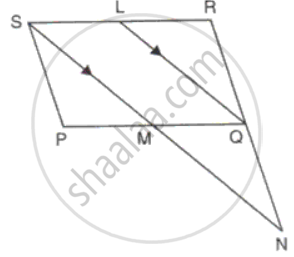Advertisements
Advertisements
प्रश्न
Prove that the line joining the mid-points of the diagonals of a trapezium is parallel to the parallel sides of the trapezium.
उत्तर
Given: Let ABCD be a trapezium in which AB || DC and let M and N be the mid-points of the diagonals AC and BD, respectively.

To prove: MN || AB || CD
Construction: Join CN and produce it to meet AB at E.
In ΔCDN and ΔEBN, we have
DN = BN ...[Since, N is the mid-point of BD]
∠DCN = ∠BEN ...[Alternate interior angles]
And ∠CDN = ∠EBN ...[Alternate interior angles]
∴ ΔCDN ≅ ΔEBN ...[By AAS congruence rule]
∴ DC = EB and CN = NE ...[By CPCT rule]
Thus, in ΔCAE, the points M and N are the mid-points of AC and CE, respectively.
∴ MN || AE ...[By mid-point theorem]
⇒ MN || AB || CD
Hence proved.
APPEARS IN
संबंधित प्रश्न
Show that the line segments joining the mid-points of the opposite sides of a quadrilateral bisect each other.
In a ∆ABC, D, E and F are, respectively, the mid-points of BC, CA and AB. If the lengths of side AB, BC and CA are 7 cm, 8 cm and 9 cm, respectively, find the perimeter of ∆DEF.
Let Abc Be an Isosceles Triangle in Which Ab = Ac. If D, E, F Be the Mid-points of the Sides Bc, Ca and a B Respectively, Show that the Segment Ad and Ef Bisect Each Other at Right Angles.
The diagonals of a quadrilateral intersect at right angles. Prove that the figure obtained by joining the mid-points of the adjacent sides of the quadrilateral is rectangle.
In ΔABC, D, E, F are the midpoints of BC, CA and AB respectively. Find ∠FDB if ∠ACB = 115°.
In parallelogram PQRS, L is mid-point of side SR and SN is drawn parallel to LQ which meets RQ produced at N and cuts side PQ at M. Prove that M is the mid-point of PQ.
D, E and F are the mid-points of the sides AB, BC and CA of an isosceles ΔABC in which AB = BC. Prove that ΔDEF is also isosceles.
Prove that the straight lines joining the mid-points of the opposite sides of a quadrilateral bisect each other.
In the given figure, T is the midpoint of QR. Side PR of ΔPQR is extended to S such that R divides PS in the ratio 2:1. TV and WR are drawn parallel to PQ. Prove that T divides SU in the ratio 2:1 and WR = `(1)/(4)"PQ"`.
P and Q are the mid-points of the opposite sides AB and CD of a parallelogram ABCD. AQ intersects DP at S and BQ intersects CP at R. Show that PRQS is a parallelogram.
